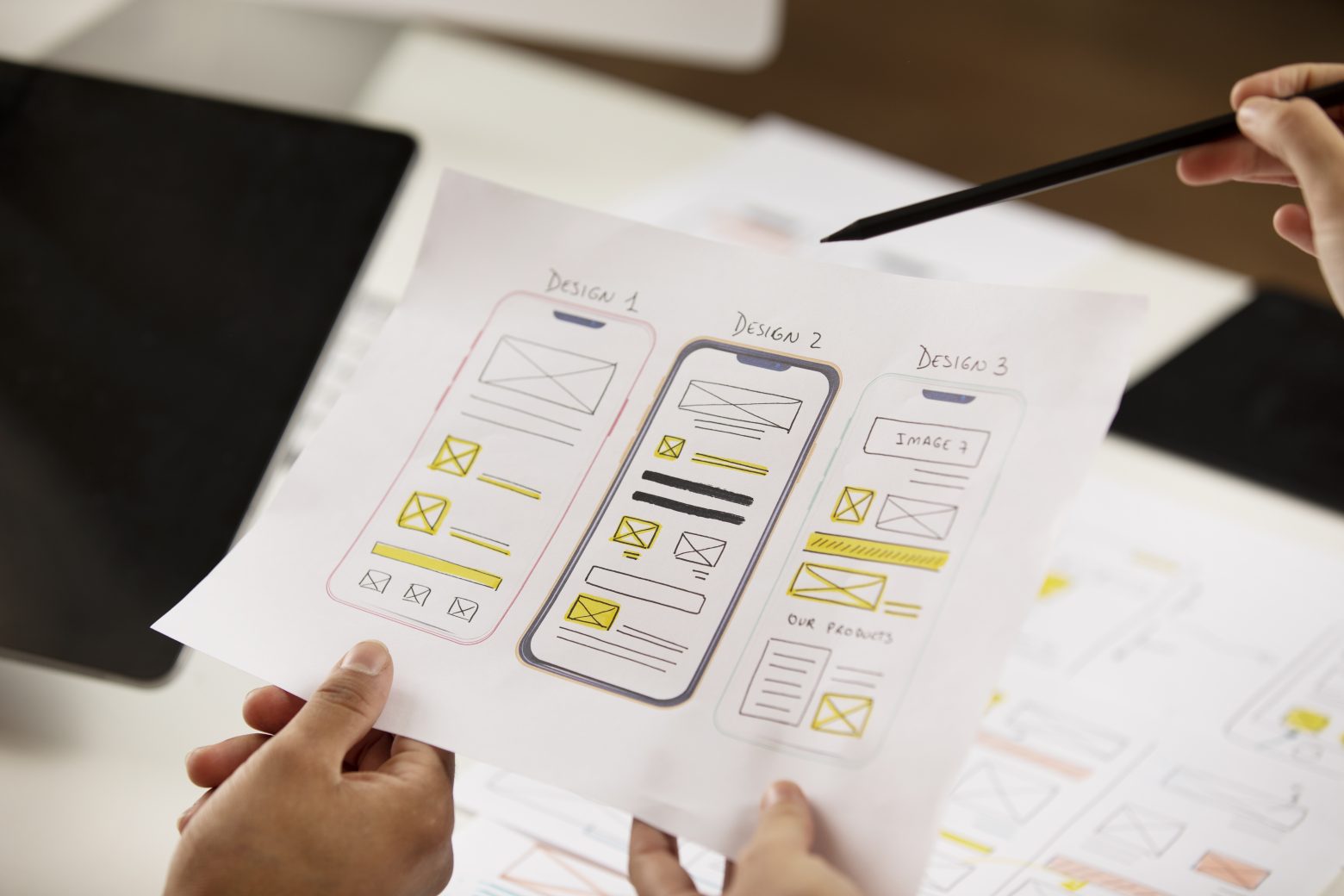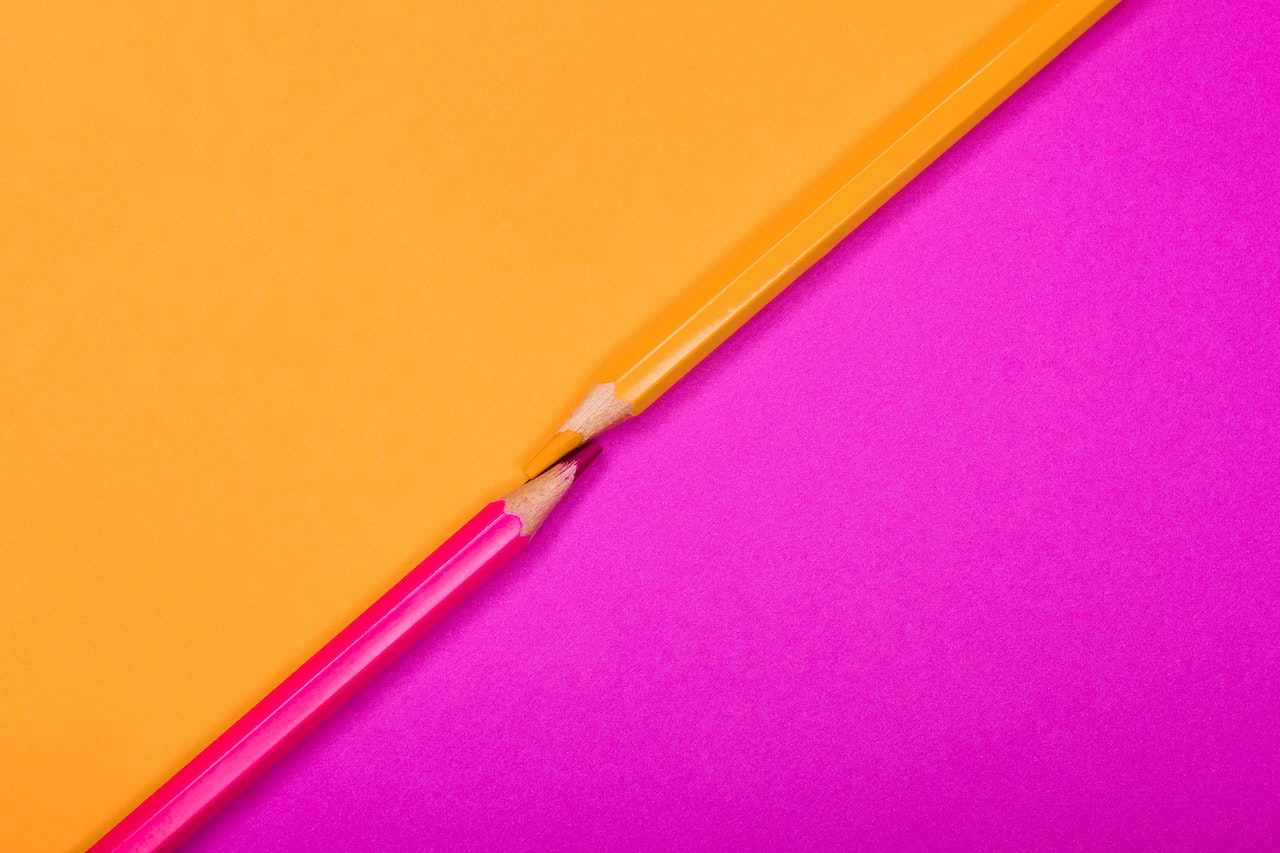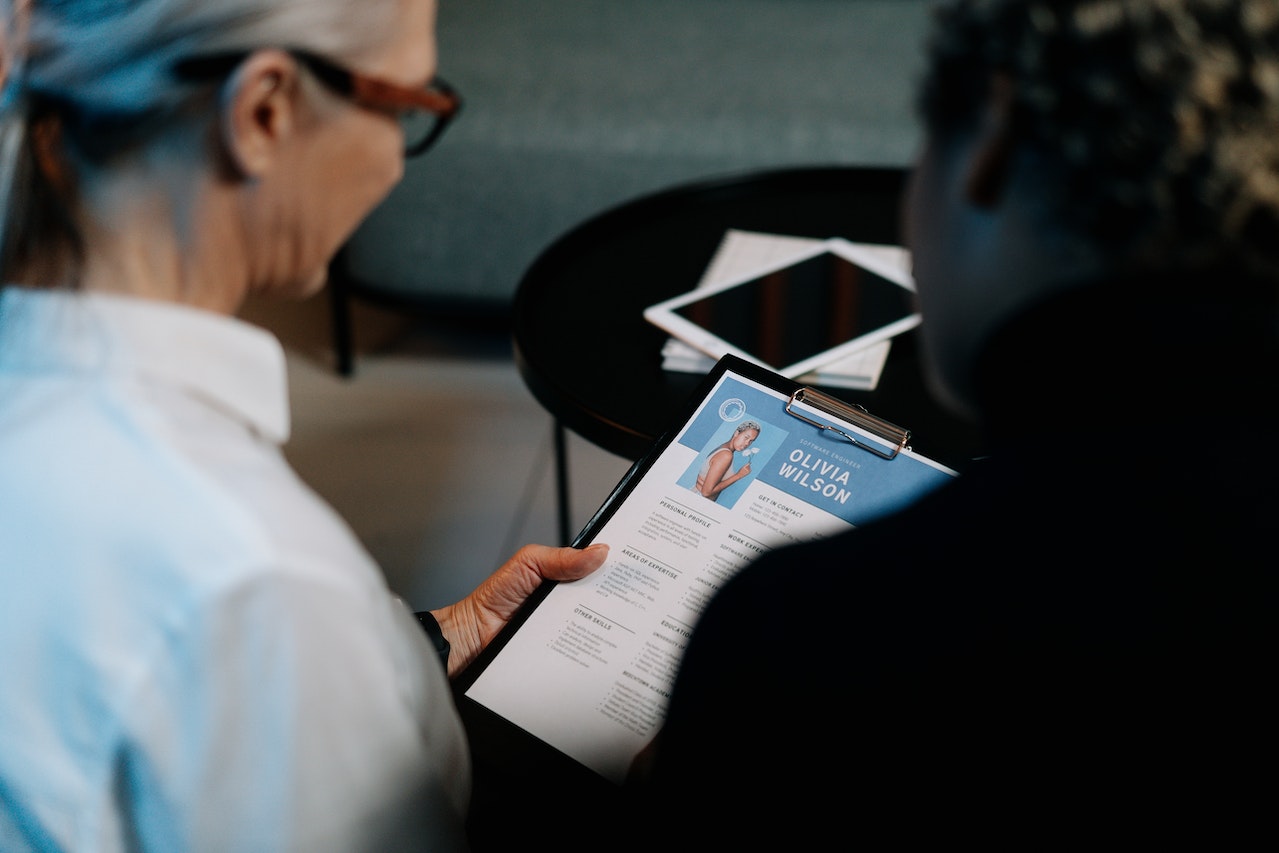12 Important UX Design Interview Questions
Published

1. Describe your design process and what methods you use

Those : jasminemoradi.com
In the area of UX-Designs New ways to solve problems are constantly sought and developed. Experienced UX designers have likely developed their own approach to the design process, which varies from one designer to another. In general, good UX designers walk you through a specific process or toolkit that they follow when tackling a problem or project. This is likely a series of steps they take to solve user problems and create engaging experiences. Look for both a clear process and specific steps they take to solve user problems and create engaging experiences.
Look for a clear process, a strong curiosity and a constant desire to learn.
An overarching theme should be a user-centered design approach and perhaps also " Design-Thinking ", which is based on a thorough understanding of both the users and the business goals. In general, it is an iterative design process that is constantly evolving. Some of the key concepts or methods used to carry out this process include: Among other things: competitive audits, stakeholder surveys, user research with interviews and surveys, content audits, information architecture, user personas, business model canvases, mood boards, storyboards, empathy maps, use case scenarios and user flows, customer journeys, wireframes, mockups and prototypes may also mention conducting user testing – moderated or unmoderated, remote or in-person – multivariate testing, eye tracking, click tracking heatmaps, and other quantitative analysis.
Also pay attention to UX design techniques such as adherence to interaction design standards, best practices, conventions, and rules of thumb known as heuristics.
By applying these UX methods and learning directly from users, each of the above techniques can play an important role in developing a product that users will love.
2. Describe a recent project that has presented you with particular challenges and how you approached the problem.
This question is designed to help you learn more about the process of being a UX designer. What was challenging for you and why? How did they go about finding a solution? While there is no right or wrong way to approach a particular challenge, having a clear strategy to achieve an end goal is essential.
For example, has additional user-generated data been collected for an existing product to identify a problem? This could mean collecting data using analytics or testing the design on a specific population in a format that makes the most sense. This could include testing wireframes or interactive prototypes on users to confirm or reject hypotheses, or sending out a survey to a broader demographic to better understand the marketability of the product.
For example, have moderated remote user testing or other remote research methods been used to listen to users and find better design solutions?
Maybe one starts UX-Designer with multivariate testing and lets the data guide him until he hits a roadblock, then iterates further until he gets a satisfactory result. UX designers love solving challenges, so a good candidate should share their excitement about how they approach problems.
3. What are the biggest challenges you face as a UX designer?
One quality of a great designer is the ability to objectively evaluate their work. No matter what stage of their career they are at, there will always be challenges that every designer tries to overcome in a meaningful way.
Look for answers that describe not only the challenges they face, but also how they overcome them.
They may find it difficult to justify their design process to certain stakeholders - it seems too expensive and takes too long. How can they overcome these obstacles?
For example, it can be difficult to convince a company that more thorough user research is needed before developing a product, or to conduct adequate usability testing during the product development cycle. How can they advocate for the above points and present their arguments?
Another challenge can be conducting user research in an innovative way. This can prove particularly difficult for designers working remotely, as direct access to their end users is limited.
Collecting, analyzing and translating qualitative and quantitative user data into “actionable insights” can be another challenge. However, good designers have a way of focusing on the most impactful elements and getting the biggest return on investment.
Look for answers that include overcoming challenges when working with others with different goals. A UX designer always faces the challenge of collaborating with professionals from other disciplines, such as: B. with C-level executives, product managers, engineers and visual designers.
This topic can also be addressed in other ways, for example:
- Can you tell me about a time when you faced one of these challenges in a previous project and how you solved it?
- What were the results of this approach?
4. What does the term “design thinking” mean to you?
Listen to the UX designer who describes it as a user-centered design approach, a process. Tim Brown, President and CEO of IDEO, a world-renowned design consultancy, describes it this way: "Design Thinking is a human-centered approach to innovation that draws from the designer's toolbox to understand people's needs, technology's capabilities and requirements to integrate into business success."
Design thinking is a method for developing solutions and solving problems in a practical, creative way. It's about gaining insights into the unmet needs of the target group. It is a form of solution-based or solution-focused thinking with the intent of achieving a constructive future outcome. Above all, it is an approach that puts people at the center - a way of thinking in which product design is based on people's needs, motivations and behaviors.
5. Please provide some examples of your experiences with user research and usability testing

Those : blog.uxtweak.com
First and foremost, user research is about understanding your users. A good UX designer will help you design products that work well in a variety of use cases - from mobile to desktop - and for a wide range of audiences.
A UX designer should be able to explain how they think about and use user research. What “lenses” do they use when conducting user research? These can include ethnographic studies, field studies and contextual observations, focus groups, surveys and diary studies.
They should describe in detail how they determined the objectives for the research and created a research plan. How they approached the organizational aspect, how they recruited representative users, what kind of research questions they asked and how they analyzed the results. Even if there is more than one approach to conducting user research, the designer should have a clear description of the method and sample size required for a meaningful result and talk about how to interpret the data.
Look for a UX designer who knows how to measure appropriately, selecting the minimum number of subjects necessary for a valid understanding of the research, and who understands what they are testing and trying to understand.
During usability testing, the designer should explain the methods used. Were structured individual interviews conducted with users while they tried out specific tasks with product prototypes? Listen to how they would define a successful test, i.e. H. what key insights were collected and how were the data transformed into practical, actionable insights? Were moderated or unmoderated usability tests carried out? (Examples of unmoderated tests include eye tracking, click tracking heatmaps, online card sorting exercises, etc.)
6. What are the biggest trends in the UX design industry right now?
Look for passion and knowledge. A good designer will be passionate about this topic; the answer will help you understand where his current focus lies.
Also pay attention to how a UX-Designer stays up to date in the industry, such as following UX podcasts, reading UX blogs and books, attending webinars and online training to upskill, etc.
A UX designer who thinks ahead is an invaluable asset to your company. He can talk about new use cases beyond screens - or how accessibility design is an area that interests him. He can talk about new prototyping tools that save developers and designers time by turning design into code, or he can simply explain a developing trend and how great it is to be at the forefront of technology. Whatever his answer, the passion should shine through. Above all, it's not about technology, but about solving problems for users in new and efficient ways.
Ultimately, it's not about "design fads". A great UX designer doesn't follow them, but rather designs products that are durable and simply work well for the end user.
7. What approach do you take to make websites and platforms accessible to all user groups, including users with visual, hearing and motor disabilities?
Accessibility is an important issue for UX designers, especially as screens get smaller and we consume and use content everywhere. Designing digital products that can be used anywhere is critical to the success of a product. If our end user has special requirements related to sensory limitations, the design should facilitate interaction and be even more empathetic.
Make sure the designer knows and follows the World Wide Web Consortium's Web Content Accessibility Guidelines. Has he conducted an accessibility analysis on a previous project?
With the focus on accessibility, testing becomes particularly important and should be comprehensive. An application or website should be simple enough to allow for a clear end goal or user task, and innovative approaches should be used to ensure that a user with a disability can actually interact with the product. Examples include using voice commands to navigate websites and apps for people with motor disabilities, adding captions to a video for the deaf and hard of hearing, making content easier to read through screen readers for the blind, or providing an option to use large Font for users with visual impairments.
8. When a customer says, “I don’t like this design.” What do you do then?
In such a situation, a great UX designer exercises cautious restraint. They don't take criticism personally, but rather use it as an opportunity to dig deeper and uncover the real reasons why a customer doesn't like a design. Great UX designers are objective; they are based on proven principles, past experiences, white papers and studies, best practices, standards and design conventions that have been tested, studied and validated. Accordingly, they should be able to support their designs based on the aforementioned principles.
As a rule, in these cases there is a discrepancy between the customer's wishes and the designer's ideas. A good designer would take a step back and ask intelligent questions to uncover the problems the client has with the design. Is the customer subjective, e.g. B. if he says: "I don't like this color"? The designer would inquire about the reason and ensure that the client understands that design decisions are based on sound principles - color theory, for example - and not subjective opinions.
Also look for examples of how the designer supported design decisions based on analytical data and testing (to remain objective), and how he presented facts and results to support his arguments.
Some customer feedback may be provided for compelling business reasons. For example, the customer may believe that an overly simplified solution misses valuable opportunities to increase revenue. A good designer would listen patiently and incorporate the feedback into the next iteration, knowing that achieving the optimal design is a balancing act between business needs, technical feasibility and the designer's desire to create the best UX.
9. Is UX design UI design? What is the difference?
User interface (UI) design is not the same as UX design. An experienced UX design professional understands the crucial difference and can articulate it clearly. User interface design often plays an important role in a UX designer's work, but it is not the only function.
While this is happening UI-Design concerned with the effective arrangement of visual elements on a user interface, UX design focuses on people. It's about what motivates them, how they think and behave.
A great UX designer should be able to point out the differences, especially that UI-Design is just a part of the UX design process and just one of many different disciplines that come under the UX banner. These include, but are not limited to: a user-centered design strategy, defining core user demographics, creating personas, user research, information architecture, content strategy, interaction design, visual design and usability testing.
10. Who are your design heroes? What are your favorite uses for UX? Explain why.

Those : youtube.com
Every great UX designer has at least a dozen books by design legends on their bookshelf, as well as favorite app designs that they value for the quality of the UX.
By listening to the reasons why they love their design heroes and favorite apps, you can learn a lot about a designer's everyday approach to UX - their "design thinking", their sensibility and their taste - and you'll learn what for a UX designer he is.
It's more important to pay attention to the "why" than to judge the name or the design guru. Nonetheless, here are a few to take note of: Dieter Rams (German industrial designer at Braun), Steve Jobs and Jonathan Ive (Apple), Don Norman (best known for his books on design, particularly The Design of Everyday Things), Steve Krug and Alan Cooper.
This also applies to your favorite applications. Again, the “why” is important – listen carefully to what makes the UX design their favorites. For example: Uber, Instagram, Snapseed, Spotify, Facebook and Netflix.
11. What analytical tools and key performance indicators (KPIs) did you use to evaluate your designs?
Great UX designers try to create experiences that work intuitively for a specific audience. Collecting quantitative data about the usage of a website or an application plays an important role in a UX designer's arsenal of UX success assessment tools. While user research typically focuses on qualitative data, analysis focuses on quantitative data, such as determining what actions users take when they visit a page.
There are many analytics tools and methods that track user behavior, such as eye tracking, click tracking heatmaps, and UI tagging, which tracks specific elements that users interact with on a page. Don't focus on the software tool, but pay attention to the why, the methods used and the measurements taken. What key performance indicators (KPIs) were used to evaluate the results? For example, how many users quickly went through the onboarding process or clicked on the login button - how many did the 1-click -Order set up?
12. If you were tasked with conducting a UX evaluation of a product, what would your process look like to accomplish this? Can you tell me about a project where you did this and what the outcome of the evaluation was?
When working in a collaborative environment, UX designers must communicate effectively with many different stakeholders, and the best way to ensure they are “heard” is with a compelling presentation. For example, when presenting research results or recommendations resulting from a UX evaluation of a product.
Pay attention to how the designer prepared the presentation. What processes, tools, and UX principles did they use to clearly communicate their findings and support their recommendations? A good presentation not only illustrates the solution, but also conveys to the audience the process by which the designer arrived at that solution.
If they did some testing and quantitative evaluations, what benchmarks and KPIs did they compare and how did they communicate those results?








